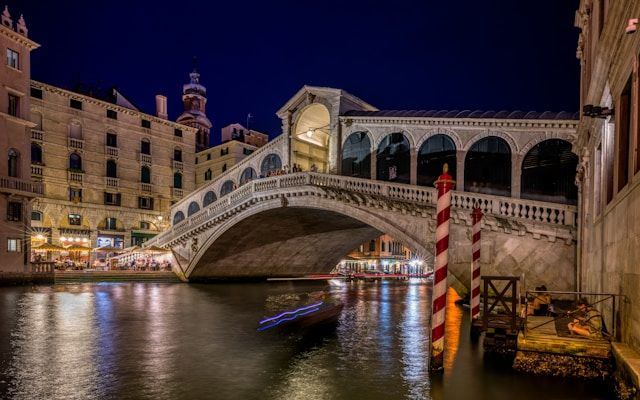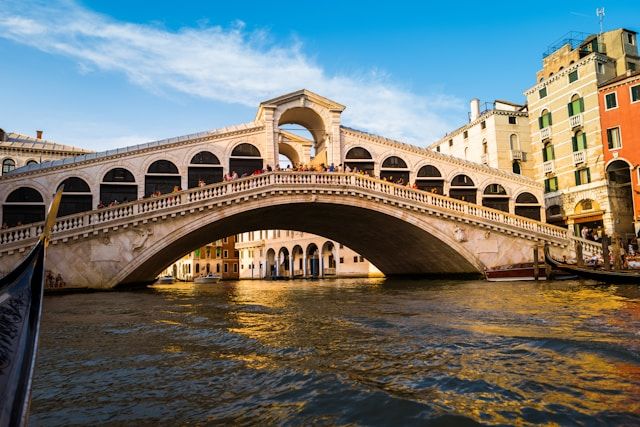Hey dear traveler, if you're dreaming of Venice's narrow alleys, the scent of salt in the air, and the timeless charm of its historic bridges, you're in the right place! Today, we bring you to discover one of the ultimate symbols of La Serenissima: the magnificent Rialto Bridge.
Get ready to be amazed, because behind every stone lies a story, fascinating 18 fun facts about the Rialto Bridge in Venice, and timeless legends.
Let’s uncover everything in this guide by Venice Insider Guide!
18 Fun Facts about the Rialto Bridge in Venice

When you think of Venice, besides canals and gondolas, one of the first images that comes to mind is definitely the Rialto Bridge. But have you ever wondered what secrets, anecdotes and mysteries lie behind this architectural masterpiece? If you think you already know everything about the Rialto Bridge, prepare to be surprised! In this fascinating journey we will go beyond mere visual beauty to discover many trivia about the Rialto Bridge that you may have never heard of.
In the next few lines we will explore its thousand-year history, starting from its earliest origins, when it was not yet the majestic bridge we see today, but rather a simple floating passageway formed by boats.
We will find out how it evolved over time and why precisely the Rialto became the beating heart of mercantile Venice. I will tell you about the competition that saw great architects like Michelangelo and Palladio compete, and how Antonio Da Ponte, perhaps less famous but incredibly ingenious, succeeded in creating a visionary design that still amazes architects and engineers around the world.
We will see how the Rialto Bridge is not only a work of art, but also a vital center of the city: a place of trade, exchange and meetings since the Middle Ages. I will also reveal curious details about its dimensions, the materials used and the pioneering construction techniques that enabled the bridge to endure for more than four centuries, despite constant traffic and the pitfalls of the brackish water of the lagoon.
There will of course be no shortage of legends: prepare to discover the eerie story of the pact with the devil, a tale that adds a touch of mystery and magic to the Rialto Bridge. I will also tell you about the resounding collapses involving previous wooden bridges, events that finally led to the decision to erect a more solid and durable stone structure.
We will then delve into the meaning of the name “Rialto” and I will take you on a visual journey through the wonder that can be enjoyed from the top of the bridge: a unique panorama of the Grand Canal, with gondolas, waterbuses and palaces reflected in the water as if in a timeless painting.
If you've ever wondered how long it is, how high it is, or how much it cost to build, you'll also find all these answers. But that's not all: you'll discover why the Rialto Bridge has a historical and economic importance that goes far beyond aesthetics, representing one of the first places in the world where modern banking activities were developed.
In short, we are about to embark together on a journey of history, art, engineering and legend. I guarantee that once you have finished reading these 18 interesting fun facts, you will look at the Rialto Bridge with completely new eyes. It will no longer be just a marvel to be photographed, but an authentic treasure chest of stories and meanings.
Are you ready to be amazed? Then let's get started right away: Venice and its Rialto Bridge are waiting for you!
1. The Rialto Bridge is the most famous in Venice
One of the first fun fact about the Rialto Bridge is just that: is the most famous in Venice.
Among the 400+ bridges crisscrossing Venice, the Rialto Bridge is by far the most famous. This bridge is not just a way to cross the Grand Canal: it’s a global icon. It appears on postcards, paintings, souvenirs, and is often the very first image that comes to mind when thinking of Venice. The Rialto Bridge has inspired writers, poets, and even movie directors, becoming an immortal symbol of beauty, art, and architectural mastery.
2. The First Rialto Bridge is oldest bridge in Venice
Let's talk about the second curiosity about the Rialto Bridge.
Did you know the Rialto Bridge is the oldest bridge spanning the Grand Canal? Its origins date back to 1173, when it first appeared as a floating bridge made of boats. Later, in 1255, it was replaced with a wooden structure. However, due to fires, uprisings, and the heavy crowds during public events, the bridge was severely damaged multiple times, leading to the decision to finally construct a permanent stone bridge.
3. The Architect of Rialto Bridge is Antonio Da Ponte
Architect Antonio Da Ponte won a prestigious competition to design the new Rialto Bridge, defeating ambitious proposals from the likes of Michelangelo and Palladio. Da Ponte envisioned a single-span bridge, a daring engineering choice at the time. His design required a deep understanding of structural challenges posed by the water and muddy lagoon foundations. The result was a masterpiece of hydraulic and architectural innovation.
4. Visiting the Rialto Bridge in Venice is free
Visiting the Rialto Bridge in Venice is free? Yes! This is one of the fun facts about the Rialto Bridge in Venice that you need to know.
Walking across the Rialto Bridge is completely free, making the experience even more magical. It doesn’t matter the time of day or year: the bridge is always there to welcome both tourists and locals. Strolling across its time-worn stones, you’ll pass small shops selling jewelry, Murano glass, artisanal souvenirs, and you'll soak up Venice’s authentic atmosphere.
5. Why it’s called "Rialto"
The name "Rialto" comes from "Rivo Alto" (High Shore), referring to its elevated position above sea level, which protected the area from frequent flooding. This geographical advantage made Rialto the commercial and urban heart of Venice, home to the city’s most important market and many financial institutions.
6. The legend of the Rialto Bridge in Venice
Among the most intriguing fun fact about the Rialto Bridge is the legend of a pact with the devil. It is said that the demon struck a deal with architect Antonio Da Ponte: in exchange for eternal stability, the first living soul to cross the bridge would belong to him. Sadly, it turned out to be Da Ponte’s own wife. This eerie legend adds a mysterious and magical aura to this architectural marvel.
7. How tall is the Rialto Bridgein Venice
The Rialto Bridge rises about 7.5 meters (roughly 25 feet) above the average level of the Grand Canal. This allows even large boats to pass underneath, showcasing the Venetians’ incredible engineering foresight even back in the 16th century.
8. What you can see from the Rialto Bridge
From the Rialto Bridge, you can enjoy one of the most iconic views in all of Venice. Look out and you’ll see gondolas gliding silently, vaporettos bustling with tourists, the vibrant Rialto Market, and a cascade of historic palaces reflecting on the Grand Canal. At night, shimmering lights create a magical, romantic atmosphere you’ll never forget.
9. The materials of the Rialto Bridgein Venice
Among the curiosities about the Rialto Bridge in Venice expressed by people all over the world is the material.
The Rialto Bridge is built from Istrian stone, a material chosen for its outstanding resistance to the brackish lagoon waters. This light-colored limestone is famous for its durability and beauty, also featured in masterpieces like St. Mark’s Basilica and the Doge’s Palace.
10. Who built the Rialto Bridge in Venice
Building the Rialto Bridge was a massive collective effort. Hundreds of skilled craftsmen worked side by side for years. It wasn’t just masons and stonemasons: carpenters, hydraulic engineers, and master shipbuilders were essential for securing the foundations in the lagoon’s tricky, muddy ground.
11. When was the Rialto Bridge built
One of the most popular questions on the web is: "When was the Rialto Bridge built?". We now explain this fun fact on the Rialto Bridge in Venice.
Construction of the stone Rialto Bridge began in 1588 and was completed in 1591, during the reign of Doge Pasquale Cicogna. In just three years, Venice finally had a stable and stunning bridge connecting both sides of the Grand Canal.
12. Why is the Rialto Bridge famous
The Rialto Bridge is celebrated for its bold design, historical commercial importance, and strategic location. It was the beating heart of Venice’s marketplace and the cradle of early banking. This powerful connection between commerce, architecture, and innovation has made the bridge legendary across the world.
13. Where is the Rialto Bridge located in Venice (Grand Canal)
The Rialto Bridge is positioned at one of the narrowest points of the Grand Canal, linking the San Polo and San Marco districts. This strategic location was no accident: it maximized commercial traffic and allowed for the swift exchange of goods and people between the two banks.
14. What type of bridge is the Rialto Bridge
The Rialto Bridge is a single-span stone arch bridge designed to distribute weight evenly across the Grand Canal. It features a series of stepped ramps with rows of shops on either side, creating a unique blend of pedestrian and commercial space.
15. How long did it take to build the Rialto Bridge
Despite its engineering complexity, the bridge was completed in just three years. This was thanks to meticulous planning and a highly skilled workforce. Engineers faced enormous technical challenges, especially securing the stone foundations on the lagoon’s unstable, muddy seabed.
16. How long is the Rialto Bridge in Venice
The Rialto Bridge stretches 48 meters (about 157 feet) in length and roughly 22 meters (about 72 feet) in width. Its impressive size allows it to comfortably accommodate hundreds of people and dozens of shops without sacrificing structural integrity.
17. How much did the Rialto Bridge cost
The Rialto Bridge cost approximately 250,000 ducats — a staggering amount for the time. It was an enormous public investment, but one deemed necessary to secure the commercial and economic future of Venice.
18. The collapses before the current construction
The 18th fun fact on the Rialto Bridge in Venice is not the last in importance, quite the contrary.
Before the stone bridge was built, the wooden versions of the Rialto Bridge collapsed several times. In 1310, it was damaged during an uprising, and in 1444 it collapsed under the weight of a crowd watching a procession celebrating the Marquis of Ferrara’s marriage. These events convinced authorities of the urgent need for a strong, lasting stone bridge.
The fascinating of fact about the Rialto Bridge in Venice

The Rialto Bridge is undoubtedly one of Venice's most iconic landmarks, and it's hard to imagine the city without it. Spanning the Grand Canal, this remarkable structure has been a symbol of Venetian ingenuity for centuries. The stone Rialto Bridge that stands today is the third iteration of a bridge that has served as a vital crossing for centuries, connecting the districts of San Marco and San Polo. But what most people don't know is that the first Rialto bridge was actually a wooden bridge, built in the 12th century as a pontoon bridge made from boats tied together. Over the years, this initial floating structure was replaced with wooden versions, and finally, in the 16th century, the Rialto Bridge we know today was built in stone under the guidance of the architect Antonio Da Ponte.
The Rialto Bridge is not only a vital crossing for pedestrians but also a famous bridge for tourists visiting Venice, attracting thousands each year. It is the oldest bridge that crosses the Grand Canal, and while there are other bridges in the city like the Accademia Bridge and the Scalzi Bridge, the Rialto Bridge stands as the only fixed structure crossing over the canal. This bridge is famous for its single arch, a brilliant feat of engineering achievement that has allowed it to withstand centuries of foot traffic and the salty waters of the Adriatic Sea.
The bridge’s unique design, with its two inclined ramps, is both functional and beautiful. These inclined ramps were strategically designed to accommodate foot traffic between the bustling markets of the Rialto area and the residential quarters on either side of the canal. It was a clever way to ensure the Rialto market, which was Venice's main fish market, could easily be accessed by the people living in Venice’s busiest districts. Notably, the Rialto Bridge is the only one in the city that features this distinctive feature, making it a standout piece of Venetian architecture.
Constructed using dense limestone from the region of Istria, the stone Rialto Bridge was meant to be a permanent structure, in contrast to the previous versions that had been partially burnt or damaged. The Rialto Bridge was built at the narrowest point of the Grand Canal, making it a strategic location for pedestrian crossings and a central point for foot traffic. In addition to its functional role, the bridge became a visual landmark that has inspired artists, poets, and architects for generations.
The design competition for the bridge saw many famous architects of the era submit proposals, but Antonio Da Ponte’s design ultimately won due to its simplicity and practicality. His engineering achievement was made possible by his understanding of the structural challenges posed by the canal’s shifting tides and the unique challenges of building on water. Unlike the movable central section that was part of the first wooden Rialto bridge, the stone version was a fixed structure, solid and unyielding. This made it not only a functional crossing but also a monumental symbol of the city’s power and wealth during the Renaissance.
The Ponte di Rialto also served a significant economic function, linking the Rialto market with the heart of Venetian trade and finance. The Palazzo dei Camerlenghi, the seat of the Venetian treasury, is located nearby, making the bridge a symbolic connection between the commercial and governmental power of the city. In fact, the Rialto Bridge was part of the financial centre of Venice, a city whose financial centre was so influential that it spread beyond Italy, affecting trade and commerce across the entire Mediterranean.
As one of the four bridges that cross the Venice Grand Canal, the Rialto Bridge has become a part of the city’s floating city narrative. It is much more than just a functional piece of infrastructure, it’s a living monument to the city’s rich past. Visitors to Venice can stand in the middle of the bridge and look down on the water bus routes that travel along the Grand Canal, while also being surrounded by the hustle and bustle of the Rialto market. Whether you're admiring it from the Piazza San Marco or looking out from the top of the bridge at the Doges Palace or Mark's Basilica, the Rialto Bridge serves as the visual and historical centerpiece of the city.
Today, the Rialto Bridge stands as a testament to Italian city ingenuity and the spirit of innovation that has always defined Venice. From its origins as a wooden Rialto bridge to the stone Rialto Bridge that stands proudly today, it has become a symbol not only of Venice’s history but also of the resilience and creativity that helped the city become one of the most influential places in the world during the Middle Ages and beyond. Whether you visit the Ponte della Moneta, the Constitution Bridge, or simply wander through the Rialto area, no bridge in Venice captures the city’s charm and beauty quite like the Rialto Bridge.
Fun Facts about the Rialto Bridge: Conclusion

Dear travelers, now you know much more than just "it’s beautiful" about the Rialto Bridge. Every step you take across those stones will be a journey through centuries filled with merchants, brilliant architects, mysterious legends, and a city that never ceases to enchant.
When you visit Venice, pause for a moment on the Rialto Bridge: listen to the murmuring waters, imagine the cries of ancient merchants, and watch life flow past like a gondola on the Grand Canal.
And if someone asks you: "Do you know any fun facts about the Rialto Bridge?" — well, now you have 18 amazing stories to share!

